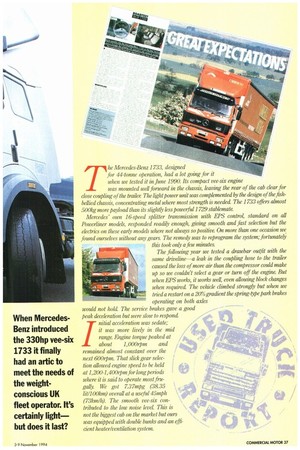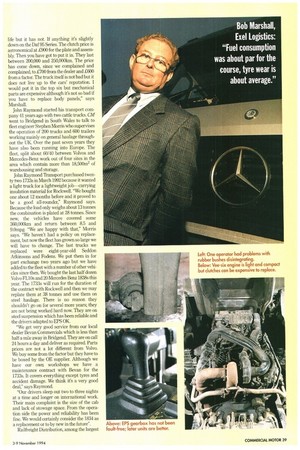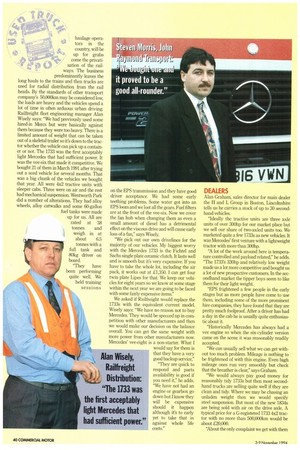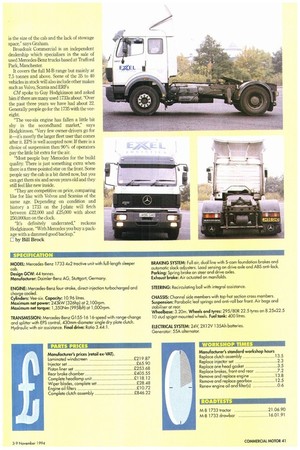lit/100km) overall at a useful 45mph (73km/h). The smooth vee-six contit
Page 39

Page 40

Page 41

Page 42

Page 43

If you've noticed an error in this article please click here to report it so we can fix it.
retained butterfly valves located close to each of the exhaust manifolds.
Mercedes had produced its own 16-speed gearbox with electro/pneumatic selection. The EPS control, standard on all Powerliner models from the 1729 to the 1748, looks like a gearlever but is a switch which moves forwards or backwards to move up or down the range. The clutch pedal is still used to complete the gear change but it's the first step in a move towards semiautomatic control Air suspension and stabiliser on the drive axle was a standard feature for the LS. Also on this model Mercedes standardized on automatic chassis lube for the first time. The braking system includes load sensing on the drive axle as well as ABS. The front axle was rated at 6.7 tonnes while the hub reduction drive axle, incorporating cross-axle differential, was rated at 11 tonnes. Two chassis offered wheelbase dimensions at 3.2m and 3.5m and it came with the long sleeper cab. The 1733 was produced alongside the 2433 which was identical with the exception of the third axle. The last models were produced in March 1992 when it was replaced by the slightly more powerful 1834.
OPERATORS
Bob Marshall, site engineering manager for Exel Logistics at Rotherham, has 12 Mercedes-Benz 1733 4x2 tractive units. The fleet, consisting of 71 tractive units and 120 box trailers including 65 refrigerated trailers, is otherwise dominated by Leyland Daf vehicles. "When we were thinking about replacing some of the tractors in 1991 we looked at Volvo, Leyland Daf and Mercedes. Previously we had bought Leyland Dafs for some time but they became a bit complacent on the sales side and, at that time, they didn't have a dealership in Sheffield," says Marshall. He explained that there are no commercial vehicle main dealers of any marque in Rotherham— Sheffield is the nearest source.
"The Mercedes 1733 was the cheapest on the initial buy. They cover about 140,000km a year double shifting. Like the rest of the fleet they are dedicated to J Sainsbury supermarkets, delivering to stores in the north of England and part of Scotland twice a day. Fresh produce is delivered early each morning and ambient/frozen goods in the afternoon. The units run with Gray and Adams triaxle fridge trailers equipped with Thermo King freezers. An average load brings the GCW to about 34 tonnes but the vehicles only operate fully laden in the one direction," says Marshall. "Fuel consumption was about par for the course when we bought them but recently we have had some Leyland Daf 85 Series on demonstration which have shown quite an improvement". Marshall expects to change the tractive units after five years and the trailers after 10. Residuals don't concern him too much as the trucks are bought under a guaranteed buy-back deal. "We specified them with air suspension, hoping to take advantage of 11.5 tonnes on the drive axle. But that didn't happen. The trailers are all on air—it's kinder to the load.
"We've had a few problems with the A frame over the axle casing. It came adrift when the rubber bushes disintegrated and left the axle live in the frame.
"The accelerator works mechanically down to the engine compartment and then it goes electric, we had several failures of the linear actuators. In the cab a couple of the computer modules went down.
"EPS has been pretty good and only two needed to be reprogrammed.
"Tyre wear is about average. We were on Uniroyals from new and then on to Bandags. There were problems with the brakes grabbing on the early ones until we had the linings and drums remachined.
"The backup has not been as good as Daf's. Mercedes still need to do some work on its roadside assistance: Daf always tell us when help is on the way. We need to know that to keep the customer informed," says Marshall "Two have had engine failures through oil starvation of the crankshaft. Mercedes exchanged them and returned them to Germany, but we don't know the cause yet. We operate a 40,000km drain period and are just looking at K and N long-life air filters. They are good for about 18 months which is a lot better than four a year. We have our own smoke meter so we check them every time we do an engine service.
"We thought that EPS would extend clutch life but it has not. If anything it's slightly down on the Daf 95 Series. The clutch price is astronomical at £900 for the plate and assembly. Then you have got to put it in. They last between 200,000 and 250,000km. The price has come down, since we complained and complained, to £700 from the dealer and £600 from a factor. The truck itself is not bad but it does not live up to the cars' reputation. I would put it in the top six but mechanical parts are expensive although it's not so bad if you have to replace body panels," says Marshall.
John Raymond started his transport company 41 years ago with two cattle trucks. CM went to Bridgend in South Wales to talk to fleet engineer Stephen Morris who supervises the operation of 200 trucks and 600 trailers working mainly on general haulage throughout the UK. Over the past seven years they have also been running into Europe. The fleet, split about 60/40 between Volvos and Mercedes-Benz work out of four sites in the area which contain more than 18,500m2 of warehousing and storage.
John Raymond Transport purchased twenty two 1733s in March 1992 because it wanted a light truck for a lightweight job—carrying insulation material for Rockwell. "We bought one about 12 months before and it proved to be a good all-rounder," Raymond says. Because the load only weighs about 13 tonnes the combination is plated at 28 tonnes. Since new, the vehicles have covered some 360,000km and return between 8.5 and 9.0mpg. "We are happy with that," Morris says. "We haven't had a policy on replacement, but now the fleet has grown so large we will have to change. The last trucks we replaced were eight-year-old Seddon Atkinsons and Fodens. We put them in for part exchange two years ago but we have added to the fleet with a number of other vehicles since then. We bought the last half dozen Volvo FLIas and 20 Mercedes Benz 1838s this year. The 1733s will run for the duration of the contract with Rockwell and then we may replate them at 38 tonnes and use them on steel haulage. There is no reason they shouldn't go on for several more years; they are not being worked hard now. They are on steel suspension which has been reliable and the drivers adapted to EPS OK.
"We get very good service from our local dealer Bevan Commercials which is less than half a mile away in Bridgend. They are on call 24 hours a day and deliver as required. Parts prices are not a lot different from Volvo.
We buy some from the factor but they have to be boxed by the OE supplier. Although we have our own workshops we have a maintenance contract with Bevan for the 1733s. It covers everything except tyres and accident damage. We think it's a very good deal," says Raymond.
"Our drivers sleep out two to three nights at a time and longer on international work.
Their main complaint is the size of the cab and lack of stowage space. From the operation side the power and reliability has been fine. We would certainly consider the 1834 as a replacement or to by new in the future".
Railfreight Distribution, among the largest haulage operators in the
41.4 country, will be
up for grabs up for grabs come the privati sation of the rail ways. The business predominantly leaves the long hauls to the trains and then trucks are used for radial distribution from the rail heads. By the standards of other transport company's 50,000km may be considered low, the loads are heavy and the vehicles spend a lot of time in often arduous urban driving. Railfreight fleet engineering manager Alan Wisely says: "We had previously used some hired-in Mercs but were basically against them bemuse they were too heavy. There is a limited amount of weight that can be taken out of a skeletal trailer so it's down to the tractor whether the vehicle can pick up a container or not. The 1733 was the first acceptably light Mercedes that had sufficient power. It was the vee-six that made it competitive. We bought 21 of them in March 1991 after trying out a seed vehicle for several months. That was a big chunk of the vehicles we bought that year. All were 4x2 tractive units with sleeper cabs. Three were on air and the rest had mechanical suspension. Wentworth Park did a number of alterations. They had alloy wheels, alloy catwalks and some 60-gallon fuel tanks were made up for us. All are rated at 38 tonnes and weigh in at about 6.5 tonnes with a full tank and 80kg driver on board.
"They have been performing quite well. We held training sessions on the EPS transmission and they have good driver acceptance. We had some early teething problems. Some water got into an EPS loom and we lost all the gears. Fuel filters are at the front of the vee-six. Now we cover the fan hub when changing them as even a small amount of diesel has a detrimental effect on the viscous drive and will cause early loss of a fan," says Wisely.
"We pick out our own drivelines for the majority of our vehicles. My biggest worry with the Mercedes 1733 is the Fichte] and Sachs single plate ceramic clutch. It lasts well and is smooth but it's very expensive. If you have to take the whole lot, including the air pack, it works out at £1,350. I can get four twin plate Lipes for that. We keep our vehicles for eight years so we know at some stage within the next year we are going to be faced with some fairly expensive items."
We asked if Railfreight would replace the 1733s with the equivalent current model. Wisely says: "We have no reason not to buy Mercedes. They would be specced up in competition with other manufacturers and then we would make our decision on the balance overall. You can get the same weight with more power from other manufacturers now. Mercedes' vee-eight is a non-starter. What I would say for them is that they have a very good backup service," "They are quick to respond and parts availability is good if you need it," he adds. "We have not had an engine or gearbox go down but! know they will be expensive should it happen although it's to early yet to take that in against whole life costs." Alan Graham, sales director for main dealer the H and L Group in Boston, Lincolnshire tells us he carries a stock of up to 30 secondhand vehicles.
"Ideally the tractive units are three axle units of over 300hp for our market place but we sell our share of two-axled units too. We marketed quite a few 1733s as new vehicles. It was Mercedes' first venture with a lightweight tractor with more than 300hp.
"A lot of the work around here is temperature controlled and payload related," he adds. "The 1733's 330hp and relatively low weight made us a lot more competitive and bought us a lot of new prospective customers. In the secondhand market the tipper boys seem to like them for their light weight.
"EPS frightened a few people in the early stages but as more people have come to use them, including some of the more prominent hire companies, they have found that they are pretty much foolproof. After a driver has had a day in the cab he is usually quite enthusiastic about it.
"Historically Mercedes has always had a vee engine so when the six-cylinder version came on the scene it was reasonably readily accepted.
"We can usually sell what we can get without too much problem. Mileage is nothing to be frightened of with this engine. Even high mileage ones run very smoothly but check that the breather is clear," says Graham.
"We would always pay good money for reasonably tidy 1733s but then most secondhand trucks are selling quite well if they are clean and tidy. Where we may be chasing an unladen weight then we would specify steel suspension. But most of the new 1834s are being sold with air on the drive axle. A typical price for a G-registered 1733 4x2 tractor with no more than 500,000km would be about .C20,000.
"About the only complaint we get with them is the size of the cab and the lack of stowage space," says Graham.
Broacloak Commercial is an independent dealership which specialises in the sale of used Mercedes-Benz trucks based at Trafford Park, Manchester.
It covers the full M-B range but mainly at 7.5 tonnes and above. Some of the 35 to 40 vehicles in stock will also include other makes such as Volvo, Scania and ERFs CM spoke to Guy Hodgkinson and asked him if there are many used 1733s about. "Over the past three years we have had about 22. Generally people go for the 1735 with the veeeight.
"The vee-six engine has fallen a little bit shy in the secondhand market," says Hodgkinson. "Very few owner-drivers go for it—it's mostly the larger fleet user that comes after it. BPS is well accepted now. If there is a choice of suspension then 90% of operators pay the little bit extra for the air.
"Most people buy Mercedes for the build quality There is just something extra when there is a three-pointed star on the front. Some people say the cab is a bit dated now, but you can get them six and seven years old and they still feel like new inside.
"They are competitive on price, comparing like for like with Volvos and Scanias of the same age. Depending on condition and history a 1733 on the J -plate will fetch between £22,000 and £25,000 with about 250,0001un on the clock "It's definitely underrated," reckons Hodgkinson. "With Mercedes you buy a package with a dammed good backup."
by Bill Brock
































































































